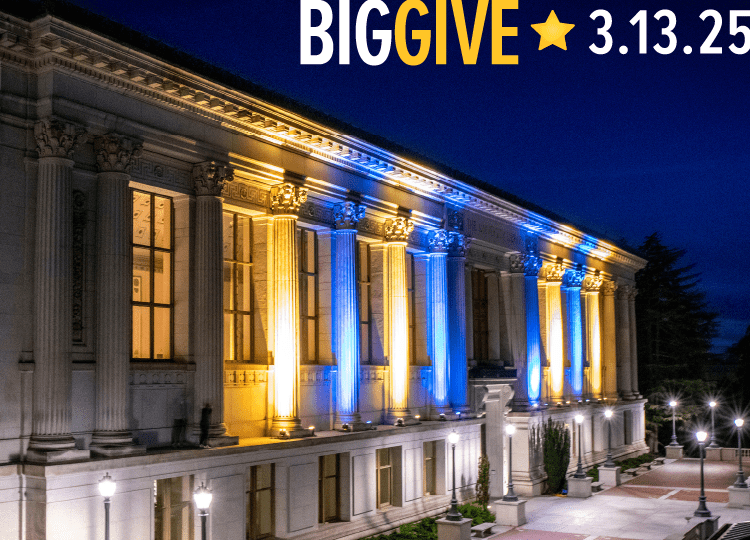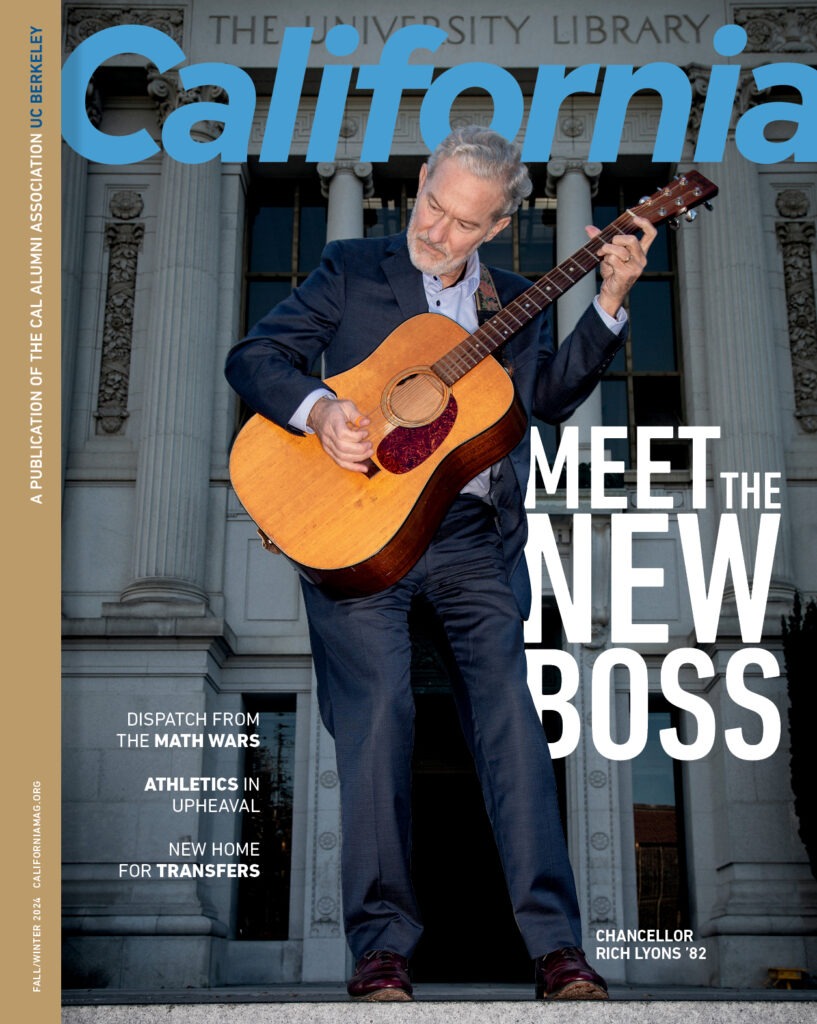Amber Cheng never expected music to be part of her adult life. Growing up in Taiwan, she had enjoyed childhood violin lessons, but when she applied to universities to study architecture, she assumed her instrument would fall by the wayside.
“I thought, OK, maybe my violin career will end here,” says Cheng. In college, she assumed, she “wouldn’t have much time to practice, or opportunities like that.” Then, as a freshman at Cal, she discovered the UC Berkeley Symphony Orchestra, a roughly 100-year-old performance group that’s open to all students, as well as community musicians.
Now, three years later, Cheng is double-majoring in music and architecture. In addition to the symphony orchestra, she plays in the Berkeley Nu Jazz Collective, helmed by acclaimed avant-garde jazz pianist and Berkeley Professor Myra Melford—even though she’d never studied jazz before coming to Berkeley. Cheng’s roommates and closest friends are musicians. And while she’s passionate about sustainable architecture, music has infiltrated her career goals as well: As a student leader in the Acoustical Society of America’s Bay Area chapter, she’s learning about becoming an acoustics consultant, and recently entered a competition to design a 1,200-seat opera house.
“Being an architect will still be my main focus, but music and sustainability will be a big part, and a space to explore,” she says.
Cheng is part of an unprecedented boom in Berkeley’s music department: As of fall 2024, she was one of nearly 200 Berkeley undergraduates who had declared music as a major, compared to just 58 music majors in the fall of 2020. That increase—238 percent over a four-year period—makes it the school’s fastest-growing major by far between 2020 and 2024.
To keep up, the school recently opened the new, state-of-the-art, 100-seat Helen and Thomas Wu Performance Hall. And on any given night of the week, music lovers can find rehearsals and jam sessions spilling forth from the classrooms in Morrison Hall, the music department’s home on campus. Demand for private lessons has exploded. The department is, accordingly, expanding and evolving to accommodate interest in its new curriculum, which has undergone perhaps the biggest transformation: Between 2020 and 2022, faculty revamped requirements for the major with an eye toward broadening appeal.

“We’ve caught up to modern times”
“I walk around the hall and poke my head into my colleagues’ classrooms, and really fun, creative things are going on,” says Melford, who’s taught at Berkeley since 2004. She credits the curriculum overhaul, which allows students to focus on a specialty earlier, for capturing young musicians’ interest. “I can see that students are super engaged.” Speaking for the faculty, she says, “it’s also been inspiring to come up with new ways of teaching and new class ideas.… There’s just a lot of energy right now that I think is super energizing for everybody.”
As part of the faculty team tasked with revising the major’s requirements early in the pandemic, Melford says equity and inclusion were front of mind. “That meant rethinking some of the classes and also strategizing about new faculty hires … so that more people would, more students would, feel represented.”
“We really wanted to broaden access to more contemporary popular music, and not just … the standard coming out of the Western classical tradition,” she says. A working musician since the ’80s, Melford was also focused on bridging the gap between the university and the Bay Area’s rich music scene.
For example, says Melford, they were looking for instructors who could teach courses using digital audio workstations, as well as other modern tools for making contemporary electronic music. “[We wanted] to have people teaching those classes who actually are part of those communities that make that music.”
The changes to the curriculum were decades in the making.
“We’ve caught up to modern times in that we understand there are a number of different ways of learning music,” Department Chair David Milnes says. “Before this, [the music curriculum] was sort of stuck in a 100-year-old paradigm of ‘Here’s what you have to learn in order to be a musician.’”
Milnes grew up in New York and played jazz professionally as a teenager. “I did not have formal music training other than on the job, and I personally know that you don’t have to take classes to become a good musician,” he says with a laugh. “And so we put that all together, slowly, in our new curriculum … and now we don’t mandate that it’s any one way.”
“The only thing that we insist on is that people do it as well as they can,” he says.

The loosened requirements mean first- and second-year music majors can get their hands on instruments sooner, and a wider range of courses can be taken to fulfill what was previously a required, classical-oriented “musicianship” series.
His sense is that “heavy Eurocentric emphasis on music theory dissuaded some people [from] becoming a music major … They have more power in terms of how they want to navigate the major,” says Juan David Rubio Restrepo, a musician and ethnomusicology scholar who joined the department in 2023.
For Rubio Restrepo, the correlation between the loosening of requirements and the increasing diversity of the department is clear: Latinx students now make up 21 percent of the department, up from 10 percent just four years ago.
While the ethnomusicology department has had Japanese and African music ensembles for decades, a new Latin American and Caribbean music ensemble was introduced in January. Already, some dozen students have enrolled.
“It speaks to the growing population in our undergrad community,” says Rubio Restrepo, who helped create the ensemble. The changing demographics also reflect, he notes, Berkeley’s aim to become a Hispanic-Serving Institution by 2028.

Cal is not alone in these changes, he says. Over the last decade, in his work at universities in his native Colombia, as well as UC San Diego and the University of Texas at El Paso, he’s seen that institutions are “rethinking the centrality of European concert music, and what music pedagogy and music itself [at a university] means,” he says. “This is an ongoing conversation.”
A sense of community
For Luke Dzwonczyk ’20, M.A. ’23, a Ph.D. student at Berkeley’s Center for New Music and Audio Technologies (CNMAT), the curriculum changes arrived too late to impact his undergraduate education. But he’s delighted to know that, apparently as a result of the loosened requirements, many students are choosing what he chose: the joys of the double-major. Of the 195 declared music majors in the fall of 2024, 60 are double majors—many of them in music and a STEM field.
This doesn’t surprise Dzwonczyk. “Hundreds of years ago, music was thought of as a science,” he says. “And having been in this music technology space for a number of years now … so many people have these two sides.” Increasingly, he believes, people are bringing the two together.
When Dzwonczyk arrived at Berkeley in 2016, he planned to major in computer science. He’d been DJing and singing since middle school but never saw it as an academic pursuit—until music technology classes showed him he could combine his interests. Today, his research focuses on sound visualization and audio generation with neural networks.

This semester, he’s also teaching the undergraduate course that first got him hooked, “Music 158: Sound and Music Computing with CNMAT Technologies.” In class, he’s seeing undergrads discover what he did: Making music is a great way to meet people.
“If it weren’t for my bands, I would have no friends,” says Roberto Ocampo, a second-year drummer who’s double-majoring in music and molecular and cell biology; he plans to become a surgeon.
“A lot of STEM classes at Berkeley feel a little like everyone’s in it for themselves … just scribbling in their little tablets,” he says. Socially, he’s found the music department to be more “loose and nice and friendly.”
Students reach out to each other to start new groups outside of academics, he notes. “I’m in two band projects … and most of the members, I’ve never even had a class with them.”
For his part, Ocampo’s a death metal fan, but since Berkeley does not yet have an official thrash ensemble, he’s planning to take lessons in jazz drumming and audition for the jazz ensemble as a junior. If that doesn’t pan out, he’ll likely try for the gamelan ensemble and learn Indonesian percussion.
“Even if I don’t do anything professional with [music],” he says, “it has benefited and complemented me and my academic progress here at Berkeley.”
What Ocampo has discovered, says Milnes, is what’s harder to quantify about the current boom in the department. It goes beyond practical discussions about career trajectories, or how the collaboration skills and work ethic students learn from music can serve students in other fields. It’s about passion.
“We’re not necessarily doing it in order to have a career path,” says Milnes. “We’re doing it because we have to do it.”
Music is blowing up at Berkeley in part, Milnes says, because it feels good—and because the pandemic made people realize that playing together is crucial for the human spirit.
“When COVID ended, we kind of were nervous about whether [students] had been playing music, and whether they would want to continue.” They needn’t have worried.
“Kids are playing music, and I think they found during COVID that it’s essential for one’s emotional and mental well-being,” he says. “Musicians have always known that, and concert-goers know it. But I think kids found this out, big time.”



















